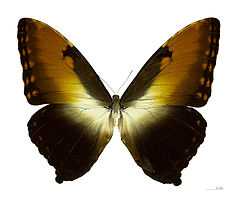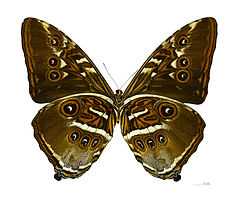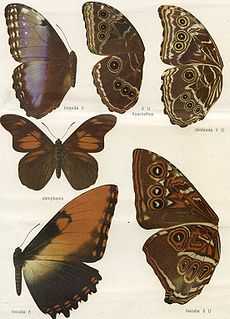Sunset Morpho
| Sunset Morpho | |
|---|---|
 | |
| Morpho hecuba hecuba - MHNT | |
 | |
| Morpho hecuba hecuba △ - MHNT | |
| Scientific classification | |
| Kingdom: | Animalia |
| Phylum: | Arthropoda |
| Class: | Insecta |
| Order: | Lepidoptera |
| Family: | Nymphalidae |
| Tribe: | Morphini |
| Genus: | Morpho |
| Species: | M. hecuba |
| Binomial name | |
| Morpho hecuba Linnaeus, 1771 | |
The Sunset Morpho (Morpho hecuba) is the largest species in the genus Morpho with a wingspan that can reach 20 centimetres (7.9 in), but is usually from 13–15 centimetres (5.1–5.9 in). "M. hecuba is the largest known Morpho and one may also call it the most interesting, on account of its habits, its susceptibility to climatic influences and its tendency to develop polychromatic forms in both sexes."[1]
Geographic range

It is a tropical butterfly only found in the northern Amazon Basin and the Guianas.
Taxonomy
It has several subspecies and has sometimes also included M. cisseis as a subspecies.

Behaviour
"We are indebted to Dr. Hahnel for the most detailed information of its habits of flight. Hahnel calls it the king of the forest, and says that it traverses a wider area than any other butterfly, travelling perhaps 30 km. or more in two or three hours, continuous flight in quest of its mate, which it follows persistently for whole days, quite alone, over woods and water-courses. In the distance the flight of Morpho hecuba looks quiet and slow, but nevertheless it moves quickly enough to evade the collector and newly emerged insects in particular adopt an impetuous pace during their first hours of flight. Sometines it happens that one of these apparently quietly hovering forms suddenly darts head downwards, and in this event it seems only to rise again with difficulty. They are driven to these violent erratic movements by dragon-flies, which lie in wait for them especially in marshy places and molest them from the tips of dry twigs, apparently more out of wantonness than from a desire to catch them." - [1]
References
- Paul Smart, 1976 The Illustrated Encyclopedia of the Butterfly World in Color.London, Salamander:Encyclopedie des papillons. Lausanne, Elsevier Sequoia (French language edition) ISBN 9780948427046 ISBN 0600313816 page 230 fig.1 ssp. obidona Fruhst. fig 6 underside (Brazil)
External links
- NSG Voucher specimen. Photograph of underside.
- Butterflies of America Images of type and other specimens.